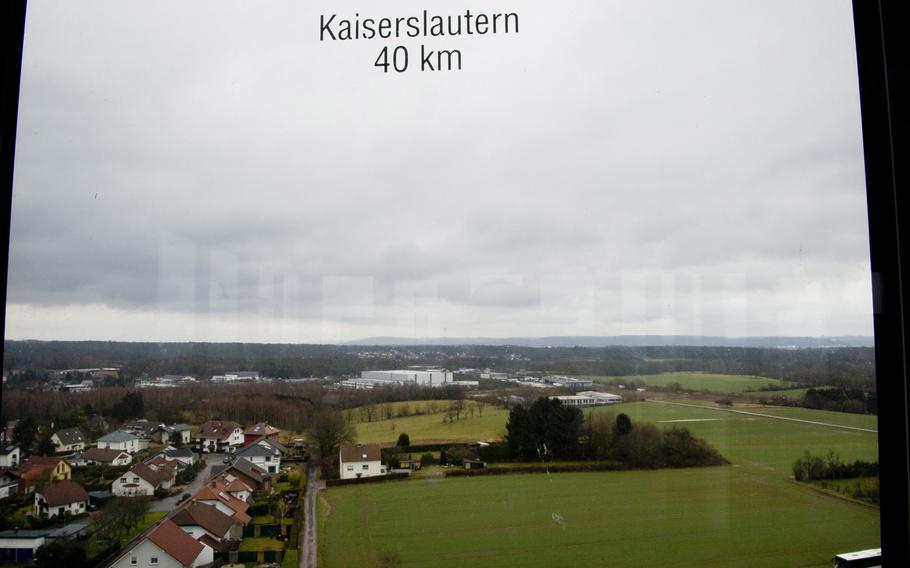
Cities, towns and distances are displayed on the windows at the top of the Saarland Mining Museum's 120-foot-tall tower in Bexbach, Germany. (Michael B. Keller/Stars and Stripes)
In June 2012, 10 train cars brought out 1,000 tons of coal from the last active mine in Saarland. It was not only the mine’s last run, but also the end of a 250-year tradition of coal mining in the western German state.
Coal production was vitally important to Saarland’s economic development. However, health issues, cheaper imported coal and environmental concerns eventually led to the industry’s local decline.
Visitors can still learn about the history of the state’s coal production at the Saarland Mining Museum in Bexbach.
The museum, originally built in 1934, is a 120-foot-tall tower about 25 miles west of Kaiserslautern that houses fossils, tools, artifacts and artwork. It reviews both ancient mining history and the more recent daily lives of miners who worked in the tunnels.
There are five sections of exhibits in the museum’s seven stories and a 600-foot-long underground gallery that showcases additional tools and equipment, while conveying some small sense of what working conditions in a mine were like.
The tour starts with an elevator ride to the top of the tower and a 360-degree view of the surrounding area with city, town and distance markers on the windows.
A stairway adorned with large photographs of the region’s mines from the 19th and 20th centuries winds down through the rest of the museum, but the elevator is also an option for reaching the lower floors.
English-language information is sparse; on several occasions I had to use Google’s translate app to decipher the information presented by an exhibit. But many of the items are labeled and paired with pictures, such as a toilet bucket with a picture from 1976 of a man demonstrating how to use it.
After you crouch under ceiling supports through the first section of the museum’s underground section, you can stand up straight again and see a fully stocked mining tool workshop, a miner’s train and a whole slew of extraction equipment that looks like it’s just waiting for someone to flip the switch to harvest fossil fuel from the rocks.
My visit took just over an hour and a half, which left me plenty of time to explore the park that surrounds the mining museum and its wonderful collection of miniature, world-famous buildings and landmarks. There are scaled models of London’s Big Ben, a section of the Berlin Wall and a nearly 32-foot-tall Eiffel Tower replica, to name a few. Best of all, admission to the park is free and it’s open all year.
After all that, if you still haven’t had your fill of exploring underground sites, check out the Schlossberg Caves (tinyurl.com/yc6xf8nn) in nearby Homburg.
DIRECTIONS: Niederbexbacher Str. 62, 66450 Bexbach Free parking is available in a large lot across the street.
TIMES: 9 a.m. to 5 p.m. Monday-Friday and 10 a.m. to 6 p.m. on weekends and holidays from March 1-Sept. 30; 9 a.m. to 4 p.m. Monday-Friday and 1 p.m. to 6 p.m. weekends and holidays from Oct. 1-Feb. 28; Last admission is 60 minutes before closing; closed Dec. 24 and Dec. 31.
COSTS: 4.80 euros ($5.94) for adults and 3.80 euros ($4.70) for students. Family tickets for two adults and children are 10 euros ($12.37).
FOOD: There are several restaurants in Bexbach and more choices in nearby Homburg.
INFORMATION: Phone: (+49) (0)6826-4887, website (in German, but Google’s translate to English function works well): www.saarl-bergbaumuseum-bexbach.de